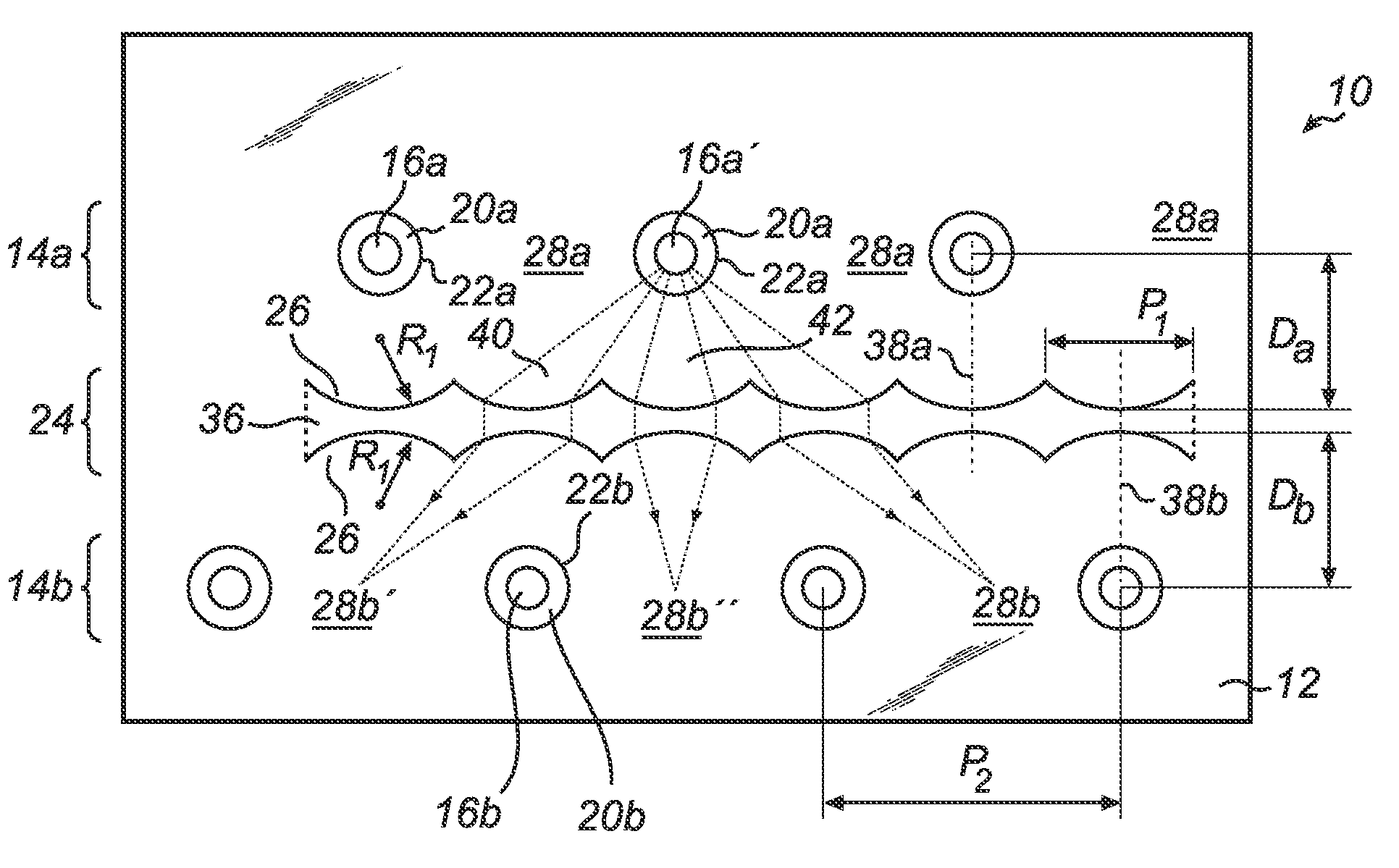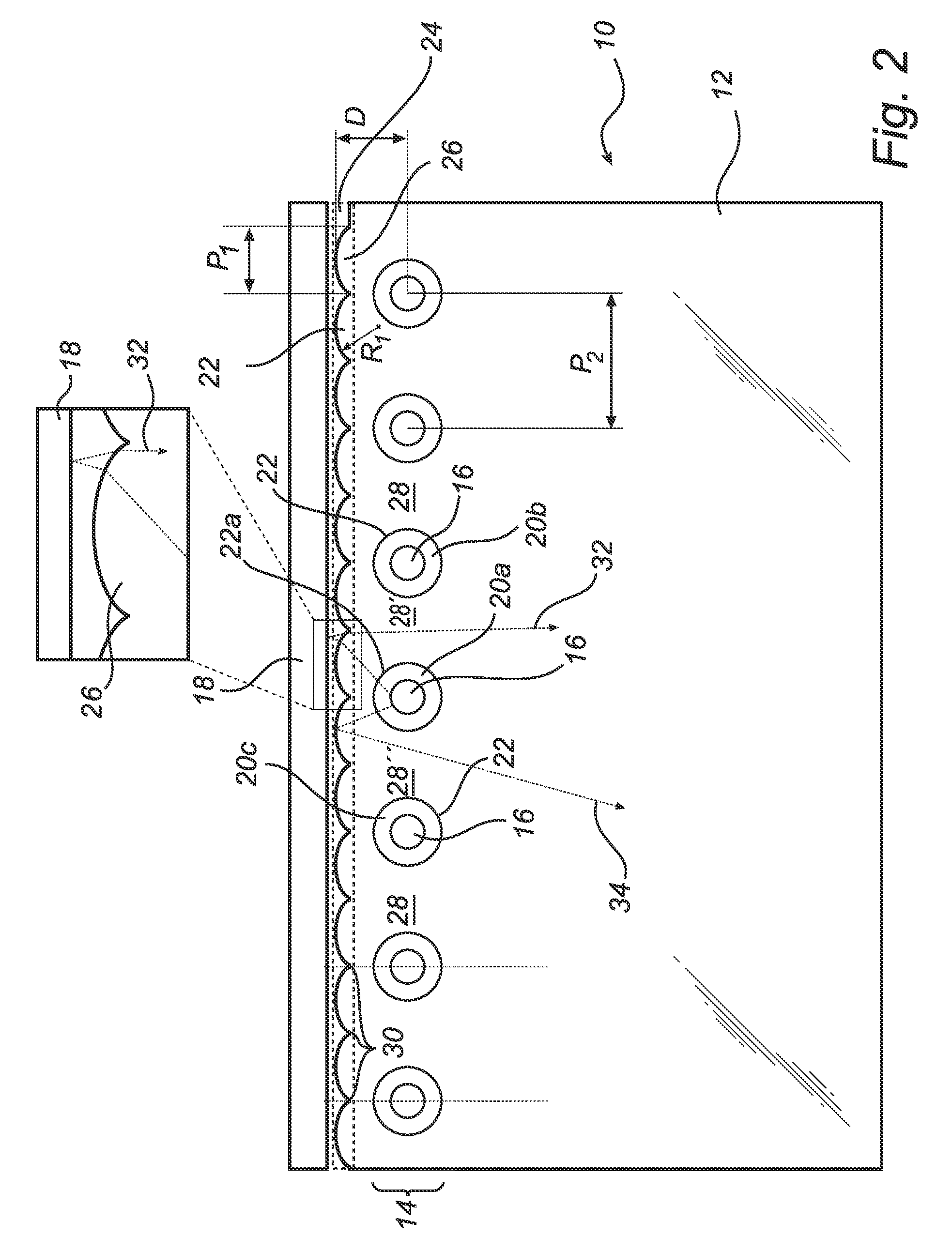Lighting device employing a light guide plate and a plurality of light emitting diodes
a light guide plate and light-emitting diode technology, applied in lighting and heating apparatus, planar/plate-like light guides, instruments, etc., can solve the problems of degrading the lumen efficiency of such a lighting device, insufficient light of a single led, etc., and achieve the effect of improving the lumen efficiency
- Summary
- Abstract
- Description
- Claims
- Application Information
AI Technical Summary
Benefits of technology
Problems solved by technology
Method used
Image
Examples
first embodiment
[0019]A light emitting diode (LED) based lighting device according to the present invention will now be described with reference to FIG. 2.
[0020]The lighting device denoted 10 comprises a light guide plate 12. The light guide plate 12 is transparent and can be made of glass or plastics (such as PMMA or PC), for example.
[0021]The lighting device 10 further comprises a linear array 14 of LEDs 16 arranged along a reflective edge 18 belonging to the light guide plate 12. The reflective edge 18 serves to direct any incident light back into the light guide plate 12, to avoid unintentional out-coupling of light from the light guide plate 12 via the edge. The LEDs 16 are preferably side-emitting omnidirectional LEDs.
[0022]The LEDs 16 are accommodated in cylindrical holes 20 having a circular lateral cross-section, which holes 20 are arranged in the light guide plate 12. ‘Lateral’ is in relation to the plane of the light guide plate. Each hole 20 has a circumferential side facet (cylinder wa...
second embodiment
[0025]A lens array can also advantageously be used in a second embodiment, wherein two LED arrays are arranged parallel to each other, as illustrated in FIGS. 3-4. The function of the lens array is here to avoid that light from one array is absorbed or scattered at LEDs in the other array.
[0026]In a first variant (FIG. 3) of the second embodiment, the lighting device denoted 10 comprises a light guide plate 12. The light guide plate 12 should be transparent and can be made of glass or plastics (such as PMMA or PC), for example.
[0027]The lighting device 10 further comprises two parallel linear arrays 14 of LEDs 16. The LEDs 16 are preferably side-emitting omnidirectional LEDs.
[0028]The LEDs 16 are accommodated in cylindrical holes 20 having a circular lateral cross-section, which holes 20 are arranged in the light guide plate 12. Each hole 20 has a circumferential side facet (cylinder wall) 22 through which light from the accommodated LED 16 is to be coupled into the light guide plat...
PUM
| Property | Measurement | Unit |
|---|---|---|
| refractive index | aaaaa | aaaaa |
| refractive index | aaaaa | aaaaa |
| radius | aaaaa | aaaaa |
Abstract
Description
Claims
Application Information
 Login to View More
Login to View More - R&D
- Intellectual Property
- Life Sciences
- Materials
- Tech Scout
- Unparalleled Data Quality
- Higher Quality Content
- 60% Fewer Hallucinations
Browse by: Latest US Patents, China's latest patents, Technical Efficacy Thesaurus, Application Domain, Technology Topic, Popular Technical Reports.
© 2025 PatSnap. All rights reserved.Legal|Privacy policy|Modern Slavery Act Transparency Statement|Sitemap|About US| Contact US: help@patsnap.com



